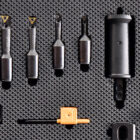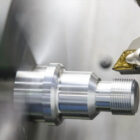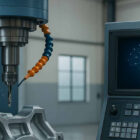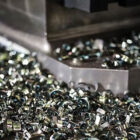Boring bars are essential tools for high-precision machining as they enable the precise expansion and fine-tuning of pre-existing holes. But just like any other tool, boring bars might have issues that lower their effectiveness and the calibre of work that is produced. It is essential to comprehend these typical problems and know how to solve them in order to maintain ideal machining conditions. This blog will discuss common issues with boring bars, such as chatter, uneven surface finish, tool wear, tool breakage, and overheating issues, and will offer workable fixes and precautions.
Chatter
What is chatter?
Chatter is the term used to describe vibrations that occur when the workpiece and the tool are being machined. These vibrations sound repetitious and rhythmic, and can lead to lower dimensional accuracy and a subpar finish.
What causes chatter?
Excessive vibrations can be caused by a boring bar that is not stiff enough or by its configuration. Chatter and instability can also be brought on by either aggressive feed rates or high cutting speeds. Vibrations can also be caused by a workpiece configuration that is unstable or by inadequate clamping. Another element that might weaken stiffness and raise the chance of chatter is excessive tool overhang.
How to deal with chatter?
- Utilizing a boring bar that is shorter in length or more appropriate for the desired depth of cut can improve stiffness by reducing tool overhang.
- Finding the ideal balance to reduce chatter can be aided by modifying feed rates and cutting speeds to optimize cutting conditions. Vibrations may usually be reduced by slowing down the cutting speed or feed rate.
- Another practical approach is to improve workpiece setup, which restricts movement, and thus reduces vibrations by making sure the workpiece is properly supported and secured. If required, think about adding more fittings or supports.
- Last but not least, it is critical to verify that the tool is properly orientated; a misaligned boring bar might result in unequal cutting pressures and exacerbate chatter.
Poor surface finish
What is poor surface finish?
Rough, uneven, or irregular surfaces on the machined hole indicate a poor surface quality.
What causes poor surface finish?
Dull tool edges are a typical source of a poor surface quality. A rough and uneven surface may result from dull or worn cutting blades. The quality of the surface finish can be greatly impacted by using the wrong cutting speeds, feeds, or depths, which are other contributing factors to this issue. Furthermore, overheating from inadequate coolant application might lead to poor surface quality. The smoothness of the surface might be further impacted by tool vibration during the cutting process.
How to deal with poor surface finish?
- Maintaining a high-quality surface finish requires routinely inspecting the boring bar and its cutting edges, as well as replacing or sharpening worn tools.
- To get a smooth surface finish, it is imperative to optimize cutting parameters, including feed rates, depths, and cutting speeds.
- Finding the ideal settings for your particular requirements may be aided by testing cuts or using the manufacturer’s advice.
- To preserve a constant surface smoothness and increase tool life, make sure coolant is applied properly to minimize heat and friction.
- Finally, to guarantee uniform cutting pressures and a constant surface quality, check and modify the boring bar’s alignment.
Tool wear
What is tool wear?
Tool wear is the term used to describe how a boring bar’s cutting edges gradually deteriorate over time. The cutting ability of the tool deteriorates with wear, which might result in worse quality and less accuracy when the holes are machined.
What causes tool wear?
Tool wear can be attributed to several sources. By putting more strain on the tool, high feed rates and cutting speeds may accelerate wear. Because of their greater resistance, materials that are tougher to machine may also wear tools more quickly. Tool wear can be further accelerated by overheating from improper coolant application. Inadequate tool care, such as missing routine checks or mishandling, can also shorten the tool’s lifespan by causing early wear.
How to deal with tool wear?
- To reduce tool wear, first optimize the cutting conditions by modifying the feed rates and cutting speeds. Make sure the cutting settings you use are suitable for the material you are machining.
- Use tools constructed of more wear-resistant materials, including carbide or high-speed steel with sophisticated coatings, for tougher materials.
- Use coolant correctly by making sure there is enough flow to lower heat and friction, which prolongs tool life and minimizes wear.
- Create a routine maintenance plan to examine, sharpen, or replace tools as needed.
- Lastly, keep an eye on wear patterns and tool performance to spot problems early and replace tools before they have a major impact on the quality of the machining.
Tool breakage
What is tool breakage?
When a boring bar or its cutting blades break or crack during machining, tool breakage occurs.
What causes tool breakage?
Excessive cutting pressures might cause the tool to shatter because they are too strong. Another important consideration is improper handling; dropping or misusing equipment can result in internal damage and raise the possibility of breakage. Additionally, severe pressure on the tool from cutting extremely hard materials might result in breakage.
How to deal with tool breakage?
- To avoid putting too much strain on the tool, lower cutting forces first by modifying the cutting settings.
- Make use of feeds and speeds that are suitable for the material being machined.
- Use appropriate handling techniques while handling instruments to prevent harm. Tools should be kept safely, and precautions should be taken to avoid drops or collisions.
- Make sure the boring bar is appropriate for the material and the machining circumstances; use equipment made to meet the project’s particular needs.
- Lastly, to avoid tool breakage while in use, perform routine tool inspections to look for indications of wear or damage, and replace tools as required.
Overheating
What is overheating?
When a cutting tool or workpiece overheats during machining, thermal damage can result that compromises the functionality of the tool as well as the quality of the workpiece.
What causes overheating?
Overheating can be caused by several sources. Increased heat production from high cutting rates might cause overheating. Another factor in this problem is the use of inadequate coolant, which can lead to the tool and workpiece overheating since it cannot adequately disperse the heat. The issue is exacerbated by dull or worn cutting edges, which increase heat and friction during machining.
How to deal with overheating?
- To minimize overheating while maintaining performance, reduce the amount of heat generated during machining by adjusting cutting speeds.
- It’s important to apply coolant more efficiently so that the tool and the workpiece are both maintained cool.
- Think about using premium coolants created especially for your machining requirements.
- To avoid overheating from dull cutting edges, regularly check the state of the cutting edges and replace or sharpen tools as necessary.
- Lastly, keep a careful eye on the cutting circumstances and modify when necessary to avoid creating too much heat accumulation.
Understanding the underlying reasons and putting workable solutions in place are necessary for effectively addressing typical boring bar issues. You can extend the life and functionality of your boring bars by keeping an eye out for problems like chatter, poor surface quality, tool wear, tool breakage, and overhang. To guarantee the effectiveness of your machining operations and provide high-quality products, you must perform routine maintenance, handle equipment carefully, and optimize cutting conditions. Whether you’re working with aluminium, steel, or other materials, taking pre-emptive measures to solve these issues will enable you to accomplish accurate, excellent results when carrying out your machining tasks. Take into consideration FineTech Toolings, well-known precision boring bars manufacturers in Bangalore, for premium quality products. FineTech Toolings is renowned for its cutting-edge solutions and highly accurate products, guaranteeing outstanding durability and performance in all of your machining tasks.






